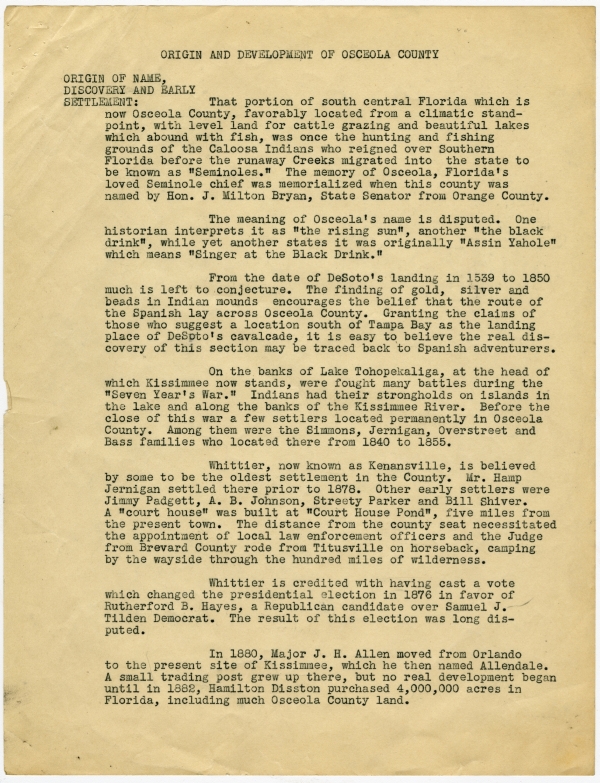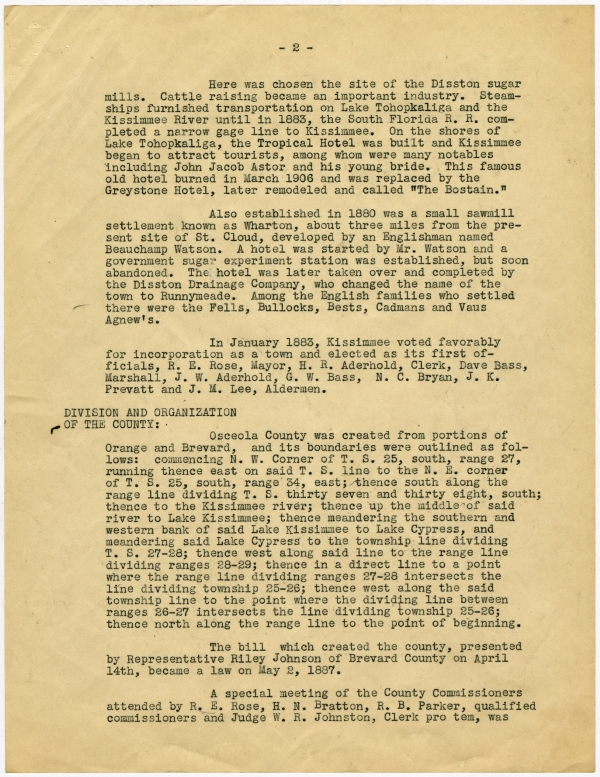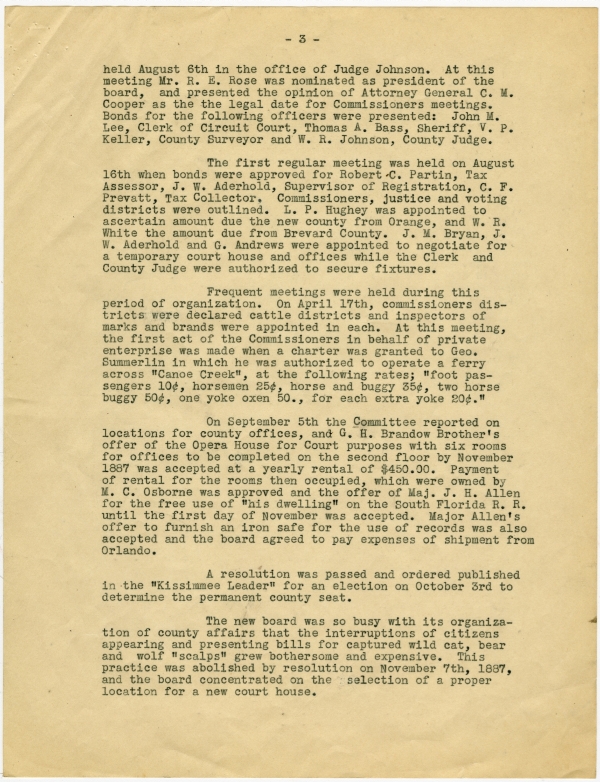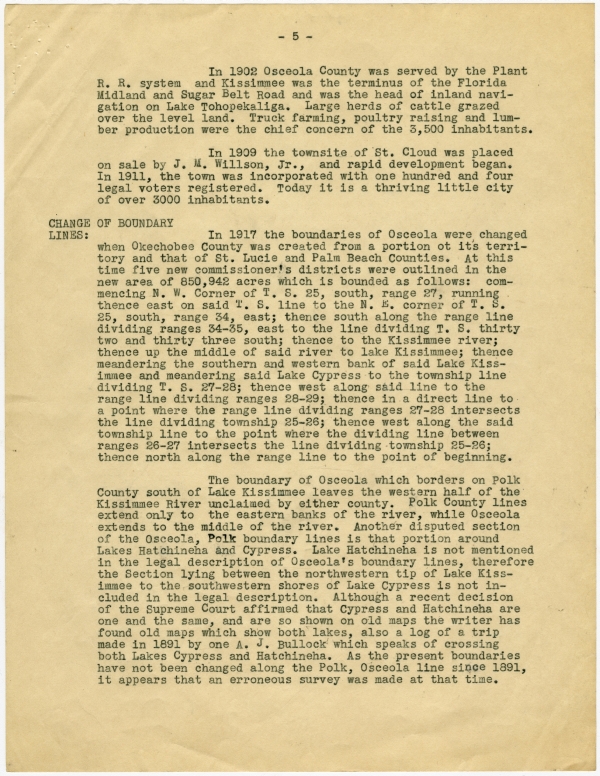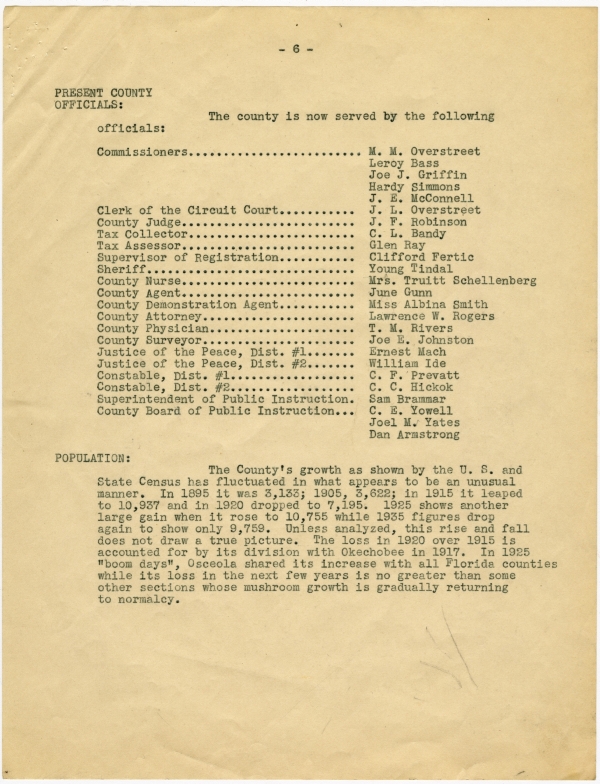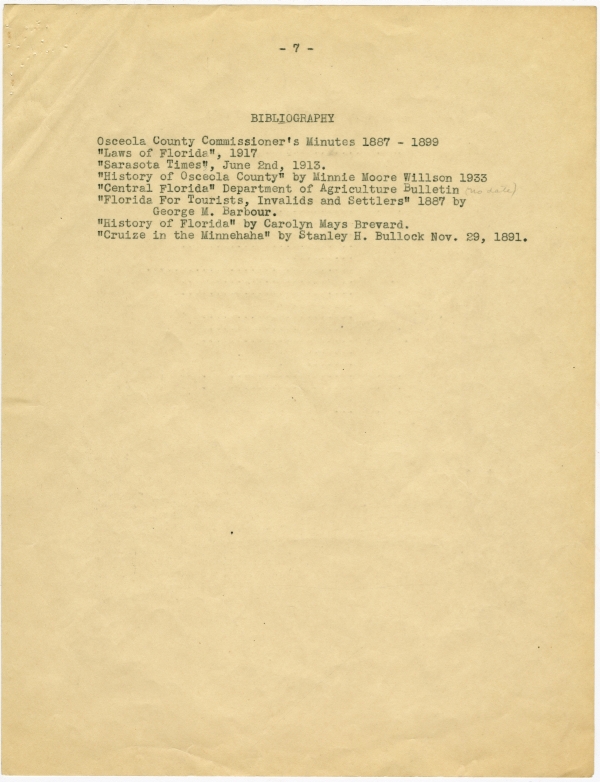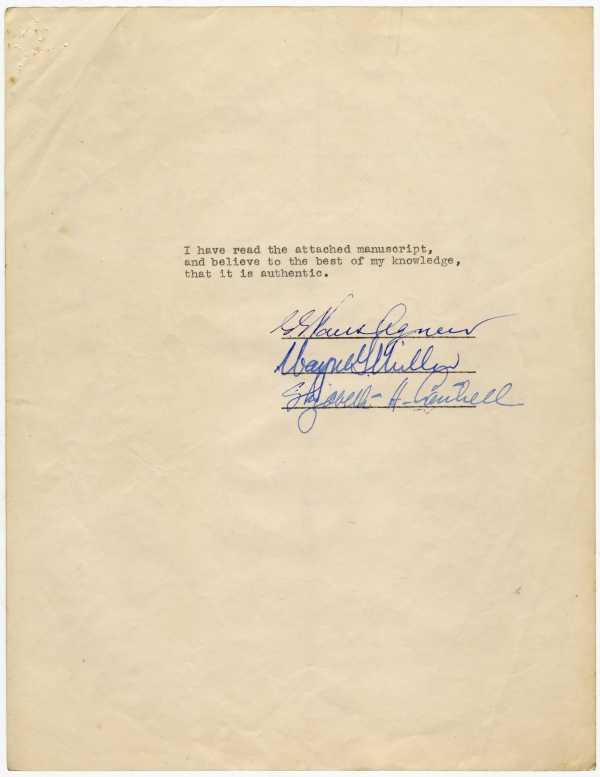Transcript
WPA
Written for the Historical
Records and State Archives
Surveys from research by
Robert W. Price, Mrs. Kate
O. Knox and the author.
(1)
New
ORIGIN AND DEVELOPMENT OF OSCEOLA COUNTY
BY
Helen A. Wells
ORIGIN AND DEVELOPMENT OF OSCEOLA COUNTY
ORIGIN OF NAME,
DISCOVERY AND EARLY
SETTLEMENT: That portion of south central Florida which is now Osceola County, favorably located from a climatic standpoint, with level land for cattle grazing and beautiful lakes which abound with fish, was once the hunting and fishing grounds of the Caloosa Indians who reigned over Southern Florida before the runaway Creeks migrated into the state to be known as "Seminoles." The memory of Osceola, Florida's loved Seminole chief was memorialized when this county was named by Hon. J. Milton Bryan, State Senator from Orange County.
The meaning of Osceola's name is disputed. One historian interprets it as "the rising sun", another "the black drink", while yet another states it was originally "Assin Yahole" which means "Singer at the Black Drink."
From the date of DeSoto's landing in 1539 to 1850 much is left to conjecture. The finding of gold, silver and beads in Indian mounds encourages the belief that the route of the Spanish lay across Osceola County. Granting the claims of those who suggest a location south of Tampa Bay as the landing place of DeSoto's cavalcade, it is easy to believe the real discovery of this section may be traced back to Spanish adventurers.
On the banks of Lake Tohopekaliga, at the head of which Kissimmee now stands, were fought many battles during the "Seven Year's War." Indians had their strongholds on islands in the lake and along the banks of the Kissimmee River. Before the close of this war a few settlers located permanently in Osceola County. Among them were the Simmons, Jernigan, Overstreet and Bass families who located there from 1840 to 1855.
Whittier, now known as Kenansville, is believed by some to be the oldest settlement in the County. Mr. Hamp Jernigan settled there prior to 1878. Other early settlers were Jimmy Padgett, A. B. Johnson, Streety Parker and Bill Shiver. A "court house" was built at "Court House Pond", five miles from the present town. The distance from the county seat necessitated the appointment of local law enforcement officers and the Judge from Brevard County rode from Titusville on horseback, camping by the wayside through the hundred miles of wilderness.
Whittier is credited with having cast a vote which changed the presidential election in 1876 in favor of Rutherford B. Hayes, a Republican candidate over Samuel J. Tilden Democrat. The result of this election was long disputed.
In 1880, Major J. H. Allen moved from Orlando to the present site of Kissimmee, which he then named Allendale. A small trading post grew up there, but no real development began until in 1882, Hamilton Disston purchased 4,000,000 acres in Florida, including much Osceola County land.
- 2 -
Here was chosen the site of the Disston sugar mills. Cattle raising became an important industry. Steamships furnished transportation on Lake [Tohopekaliga] and the Kissimmee River until in 1883, the South Florida R. R. completed a narrow gage line to Kissimmee. On the shores of Lake [Tohopekaliga], the Tropical Hotel was built and Kissimmee began to attract tourists, among whom were many notables including John Jacob Astor and his young bride. This famous old hotel burned in March 1906 and was replaced by the Greystone Hotel, later remodeled and called "The Bostain."
Also established in 1880 was a small sawmill settlement known as Wharton, about three miles from the present site of St. Cloud, developed by an Englishman named Beauchamp Watson. A hotel was started by Mr. Watson and a government sugar experiment station was established, but soon abandoned. The hotel was later taken over and completed by the Disston Drainage Company, who changed the name of the town to Runnymeade. Among the English families who settled there were the Fells, Bullocks, Bests, Cadmans and Vaus Agnew's.
In January 1883, Kissimmee voted favorably for incorporation as a town and elected as its first officials, R. E. Rose, Mayor, H. R. Aderhold, Clerk, Dave Bass, Marshall, J. W. Aderhold, G. W. Bass, N. C. Bryan, J. K. Prevatt and J. M. Lee, Aldermen.
DIVISION AND ORGANIZATION
OF THE COUNTY: Osceola County was created from portions of Orange and Brevard, and its boundaries were outlined as follows: commencing N. W. Corner of T. S. 25, south, range 27, running thence east on said T. S. line to the N. E. corner of T. S. 25, south, range 34, east; thence south along the range line dividing T. S. thirty seven and thirty eight, south; thence to the Kissimmee river; thence up the middle of said river to Lake Kissimmee; thence meandering the southern and western bank of said Lake Kissimmee to Lake Cypress, and meandering said Lake Cypress to the township line dividing T. S. 27-28; thence west along said line to the range line dividing ranges 28-29; thence in a direct line to a point where the range line dividing ranges 27-28 intersects the line dividing township 25-26; thence west along the said township line to the point where the dividing line between ranges 26-27 intersects the line dividing township 25-26; thence north along the range line to the point of beginning.
The bill which created the county, presented by Representative Riley Johnson of Brevard County on April 14th, became a law on May 2, 1887.
A special meeting of the County Commissioners attended by R. E. Rose, H. N. Bratton, R. B. Parker, qualified commissioners and Judge W. R. Johnston, Clerk pro tem, was
- 3 -
held August 6th in the office of Judge Johnson. At this meeting Mr. R. E. Rose was nominated as president of the board, and presented the opinion of Attorney General C. M. Cooper as the the [sic] legal date for Commissioners meetings. Bonds for the following officers were presented: John M. Lee, Clerk of the Circuit Court, Thomas A. Bass, Sheriff, V. P. Keller, County Surveyor and W. R. Johnson, County Judge.
The first regular meeting was held on August 16th when bonds were approved for Robert C. Partin, Tax Assessor, J. W. Aderhold, Supervisor of Registration, C. F. Prevatt, Tax Collector. Commissioners, justice and voting districts were outlined. L. P. Hughey was appointed to ascertain amount due the new county from Orange, and W. R. White the amount due from Brevard County. J. M. Bryan, J. W. Aderhold and G. Andrews were appointed to negotiate for a temporary court house and offices while the Clerk and County Judge were authorized to secure fixtures.
Frequent meetings were held during this period of organization. On April 17th, commissioners districts were declared cattle districts and inspectors of marks and brands were appointed in each. At this meeting, the first act of the Commissioners in behalf of private enterprise was made when a charter was granted to Geo. Summerlin in which he was authorized to operate a ferry across "Canoe Creek", at the following rates; "foot passengers 10¢, horsemen 25¢, horse and buggy 35¢, two horse buggy 50¢, one yoke oxen 50. [sic], for each extra yoke 20¢."
On September 5th the Committee reported on locations for county offices, and G. H. Brandow Brother's offer of the Opera House for Court purposes with six rooms for offices to be completed on the second floor by November 1887 was accepted at a yearly rental of $450.00 Payment of rental for the rooms then occupied, which were owned by M. C. Osborne was approved and the offer of Maj. J. H. Allen for the free use of "his dwelling" on the South Florida R. R. until the first day of November was accepted. Major Allen's offer to furnish an iron safe for the use of records was also accepted and the board agreed to pay expenses of shipment from Orlando.
A resolution was passed and ordered published in the "Kissimmee Leader" for an election on October 3rd to determine the permanent county seat.
The new board was so busy with its organization of county affairs that the interruptions of citizens appearing and presenting bills for captured wild cat, bear and wolf "scalps" grew bothersome and expensive. This practice was abolished by resolution on November 7th, 1887, and the board concentrated on the selection of a proper location for a new court house.
- 4 -
Many offers of sites were made, among which was that of John L. Hill, "General Manager of the Town of Runnymede", "for a valuable portion of the town", and Hon. J. M. Bryan's offer on behalf of himself and other citizens for the north half of Block A. of W. A. Patrick's addition to Kissimmee but the location finally accepted on May 7th, 1888 was Block L. known as the Stewart block which was purchased from Hon. David Steward for $2000.
In July, 1888, Commissioners grew concerned about the care of the county's indigent citizens, and recommended the purchase of 40 acres of ground owned by N. C. Bryan for $1000 but this motion was tabled and the poor farm was not purchased until 1893 when 20 acres in Section 25, Township 26 S, Range 29 E, were secured from Everett and Mariah Bass, purchase price $4000. This farm proved to be an excellent investment. From 19 acres of orange trees, the county netted approximately $1800 per year until 1925, at which time it was sold at a large profit to R. G. Johnson. In 1926 another farm was purchased from Henry Bass. This also was sold at a profit and the present farm located about 2 miles southwest from St. Cloud was purchased from William D. Seele and Wife. According to a statement made by R. E. Rose in 1913, this profitable county farm saved tax payers many dollars by actually paying for the Court House and contributing to the payment of other expenses.
COURT HOUSE:
On April 7th, 1888 the plans of F. C. Johnson were approved for the new court house, and on November 5th the temporary court house was leased for another year. February 4th, 1889, a bond issue of $30,000 for the new building was sold to Capt. Geo. H. Frost of Neponsette, Mass., and a contract was awarded to Pierce and Torrey Investment Company. After many difficulties, among which was rebuilding the tower, the building which is still in use was completed and officially occupied for the first time on May 6th, 1890.
FURTHER DEVELOPMENT:
In 1890, a Shaker colony from Lebanon, Pennsylvania settled on Lakes Isabelle and [Alligator]. Ezra Stewart was head of this group of small farmers who raised excellent pineapples and strawberries. The colony prospered for a time until one of their number was implicated in a "mercy killing". Publicity in leading newspapers is alleged to have disrupted the colony which lasted about fifteen years.
In 1893 the County's agricultural possibilities were recognized and the board appropriated $1200.00 for an exhibit at the World's Columbian Exhibition Space for Osceola County was arranged for in the agricultural building by Hamilton Disston.
- 5 -
In 1902 Osceola County was served by the Plant R. R. system and Kissimmee was the terminus of the Florida Midland and Sugar Belt Road and was the head of inland navigation on Lake Tohopekaliga. Large herds of cattle grazed over the level land. Truck farming, poultry raising and lumber production were the chief concern of the 3,500 inhabitants.
In 1909 the townsite of St. Cloud was placed on sale by J. M. Willson, Jr., and rapid development began. In 1911, the town was incorporated with one hundred and four legal voters registered. Today it is a thriving little city of over 3000 inhabitants.
CHANGE OF BOUNDARY
LINES: In 1917 the boundaries of Osceola were changed when [Okeechobee] County was created from a portion [of] its territory and that of St. Lucie and Palm Beach Counties. At this time five new commissioner's districts were outlined in the new area of 850,942 acres which is bounded as follows: commencing N. W. Corner of T. S. 25, south, range 27, running thence east on said T. S. line to the N. E. corner of T. S. 25, south, range 34, east; thence south along the range line dividing ranges 34-35, east to the line dividing T. S. thirty two and thirty three south; thence to the Kissimmee; thence meandering the southern and western bank of said Lake Kissimmee and meandering said Lake Cypress to the township line dividing T. S. 27-28; thence west along said line to the range line dividing ranges 28-29; thence in a direct line to a point where the range line dividing ranges 27-28 intersects the line dividing township 25-26; thence west along the said township line to the point where the dividing line between ranges 26-27 intersects the line dividing township 25-26; thence north along the range line to the point of beginning.
The boundary of Osceola which borders on Polk County south of Lake Kissimmee leaves the western half of the Kissimmee River unclaimed by either county. Polk County lines extend only to the eastern banks of the river, while Osceola extends to the middle of the river. Another disputed section of the Osceola, Polk boundary lines is that portion around Lakes Hatchineha and Cypress. Lake Hatchineha is not mentioned in the legal description of Osceola's boundary lines, therefore the Section lying between the northwestern tip of Lake Kissimmee to the southwestern shores of Lake Cypress is not included in the legal description. Although a recent decision of the Supreme Court affirmed that Cypress and Hatchineha are one and the same, and are so shown on old maps the writer has found old maps which show both lakes, also a log of a trip made in 1891 by one A. J. Bullock which speaks of crossing both Lakes Cypress and Hatchineha. As the present boundaries have not been changed along the Polk, Osceola line since 1891, it appears that an erroneous survey was made at that time.
- 6 -
PRESENT COUNTY
OFFICIALS:
The county is now served by the following officials:
Commissioners .........................
M. M. Overstreet
Leroy Bass
Joe J. Griffin
Hardy Simmons
J. E. McConnell
Clerk of the Circuit Court ............
J. L. Overstreet
County Judge ..........................
J. F. Robinson
Tax Collector .........................
C. L. Bandy
Tax Assessor ..........................
Glen Ray
Supervisor of Registration ............
Clifford Fertic
Sheriff ...............................
Young Tindal
County Nurse ..........................
Mrs. Truitt Schellenberg
County Agent ..........................
June Gunn
County Demonstration Agent ............
Miss Albina Smith
County Attorney .......................
Lawrence W. Rogers
County Physician ......................
T. M. Rivers
County Surveyor .......................
Joe E. Johnston
Justice of the Peace, Dist. #1 ........
Ernest Mach
Justice of the Peace, Dist. #2 ........
William Ide
Constable, Dist. #1 ...................
C. F. Prevatt
Constable, Dist. #2 ...................
C. C. Hickok
Superintendent of Public Instruction ..
Sam Brammar
County Board of Public Instruction ....
C. E. Yowell
Joel M. Yates
Dan Armstrong
POPULATION:
The County's growth as shown by the U. S. and State Census has fluctuated in what appears to be an unusual manner. In 1895 it was 3,133; 1905, 3,622; in 1915 it leaped to 10,937 and in 1920 dropped to 7,195. 1925 shows another large gain when it rose to 10,755 while 1935 figures drop again to show only 9,759. Unless analyzed, this rise and fall does not draw a true picture. The loss in 1920 over 1915 is accounted for by its division with [Okeechobee] in 1917. In 1925 "boom days", Osceola shared its increase with all Florida counties while its loss in the next few years is no greater than some other sections whose mushroom growth is gradually returning to normalcy.
- 7 -
BIBLIOGRAPHY
Osceola County Commissioner's Minutes 1887 - 1899
"Laws of Florida", 1917
"Sarasota Times", June 2nd, 1913.
"History of Osceola County" by Minnie Moore Willson 1933
"Central Florida" Department of Agriculture Bulletin (no date)
"Florida for Tourists, Invalids and Settlers" 1887 by George M. Barbour.
"History of Florida" by Carolyn Mays Brevard.
"Cruize in the Minnehaha" by Stanley H. Bullock Nov. 29, 1891.
I have read the attached manuscript,
and believe to the best of my knowledge,
that it is authentic.
? Agnew
Wayne ?
Elizabeth H. [Cantrell?]

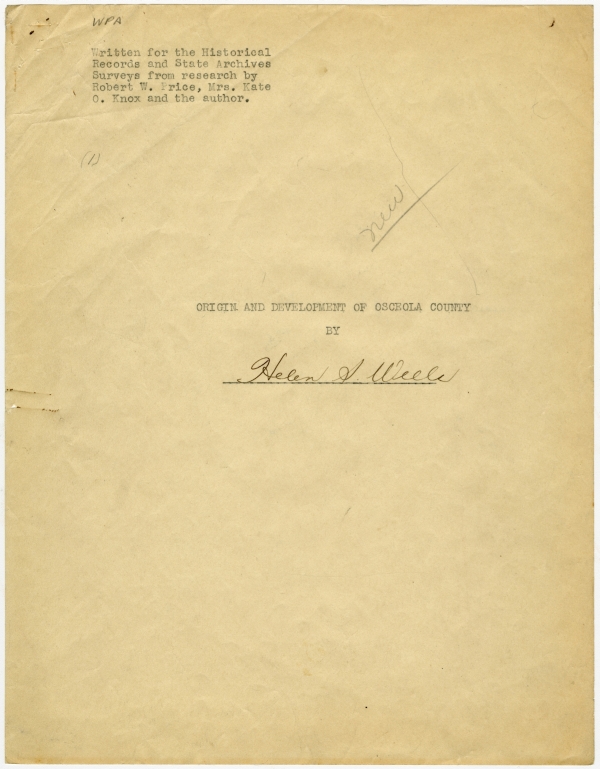


 Listen: The Bluegrass & Old-Time Program
Listen: The Bluegrass & Old-Time Program